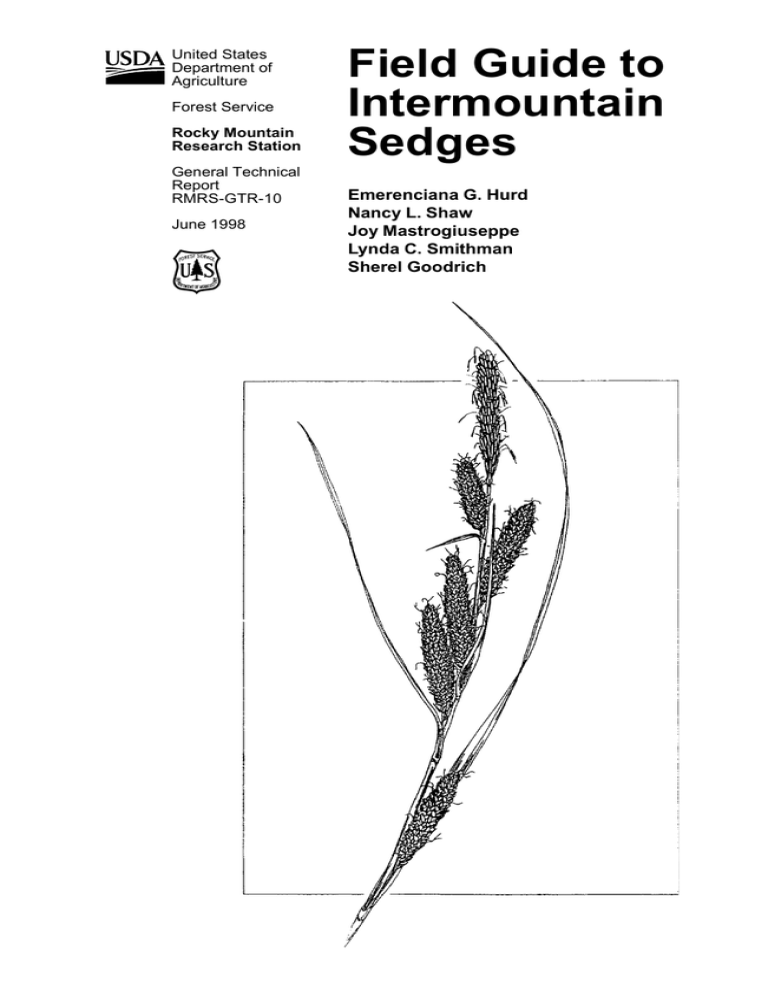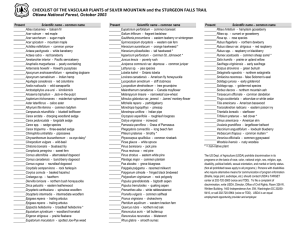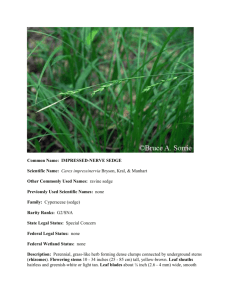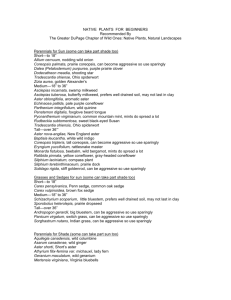Field Guide to Intermountain Sedges Emerenciana G. Hurd
advertisement

United States Department of Agriculture Forest Service Rocky Mountain Research Station General Technical Report RMRS-GTR-10 June 1998 Field Guide to Intermountain Sedges Emerenciana G. Hurd Nancy L. Shaw Joy Mastrogiuseppe Lynda C. Smithman Sherel Goodrich The Authors Emerenciana G. Hurd is a Botanist with the Rocky Mountain Research Station, Riparian-Stream Ecosystems Research Work Unit at the Forestry Sciences Laboratory in Boise, ID. Originally from the Philippines, she holds a B.S. degree in biology from Whitman College, Walla Walla, WA and M.S. and Ph.D. degrees in botany from Northern Arizona University. Nancy L. Shaw is a Botanist with the Rocky Mountain Research Station at the Forestry Sciences Laboratory in Boise, ID. She completed a B.S. degree in zoology at the College of Idaho, an M.S. degree in botany at Idaho State University, and a Ph.D. degree in crop science at Oregon State University. Joy Mastrogiuseppe is a Botanist focusing her studies on the genus Carex. She was Curator of the Marion Ownbey Herbarium, Washington State University, Pullman, until 1993 and is currently Curator of the Museum and resident Ethnobotanist for the Department of Anthropology, Washington State University. She is also associated with the Ochoco National Forest where she does botanical work in south-central and southeastern Oregon. Lynda C. Smithman is a Biological Technician-Plants with the Rocky Mountain Research Station at the Forestry Sciences Laboratory in Boise, ID. She received a B.A. degree in history from the University of Arizona and has completed post-graduate courses in botany from the College of Idaho. She has had extensive experience as a botanical consultant to both private industry and public agencies in southern Idaho and eastern Oregon. Sherel Goodrich is Range Conservationist for the Ashley National Forest, Vernal, UT. He received a B.S. degree in range management from Utah State University in 1971 and an M.S. degree in botany from Brigham Young University in 1981. He worked extensively in Utah and central Nevada when he was with the Rocky Mountain Research Station, Provo, UT. Acknowledgments Many individuals were involved in development of this field guide from its conception through field collection, curation, manuscript preparation, review, and editing. A special thanks to Warren Clary, Project Leader of the Rocky Mountain Research Station’s Riparian-Stream Ecosystems Front cover art: Carex nebrascensis, drawn by Lenora Oosterhuis, an emigrant from Holland, a Forest Ecologist, and a freelance Biological Artist living in Boise, ID. Rocky Mountain Research Station 324 25th Street Ogden, UT 84401 Research Work Unit, for suggesting the idea of preparing field guides for grasslike species of the Intermountain Region. For assistance in field collections, our appreciation goes to Gary Hurd for his willingness to visit remote mountainous terrain in search of uncommon high-elevation species; to Kenneth Gentz, Toiyabe National Forest, for his help with Nevada collections; to Martin Stein, WallowaWhitman National Forest, and Joe Duft of Boise, ID, for providing specimens; and to Richard Whitkus, University of California, Riverside, for his taxonomic assistance. Our thanks to Don Mansfield, Albertson College; Stewart Markow, Targhee National Forest; Leila Shultz, Utah State University; and Caryl Elzinga, a private consultant, of Salmon, ID, for reviewing the manuscript. For help with field collections, curation, and manuscript preparation, we extend thanks to Bobbi Fuller, Ruth Meerkatz, Danielle Scholten, and Kristie Worth. For final editing and helpful suggestions along the way, we thank the Rocky Mountain Station Research Information staff. Contents Page Introduction ................................... 1 References .................................... 2 Morphology ................................... 3 General Description: Carex L. ....... 3 Key to Intermountain Carex Species ........................... 17 Species Descriptions .................. 33 Carex abrupta ......................... 35 C. aenea ................................. 37 C. albonigra ............................ 39 C. alma ................................... 41 C. amplifolia ............................ 43 C. angustata ........................... 45 C. aquatilis ............................... 47 C. arapahoensis ..................... 49 C. arcta ................................... 51 C. atherodes ........................... 53 C. athrostachya ...................... 55 C. atrata ................................. 131 C. atrosquama ........................ 57 C. aurea .................................. 59 C. backii .................................. 61 C. bebbii ................................. 63 C. bella ................................... 65 C. bipartita .............................. 67 C. bolanderi ............................ 91 C. brevior ................................ 69 C. breweri var. paddoensis ..... 71 C. brunnescens ...................... 73 Page C. buxbaumii ........................... 75 C. canescens .......................... 77 C. capillaris ............................. 79 C. capitata .............................. 81 C. concinnoides ...................... 83 C. crawei ................................. 85 C. crawfordii ............................ 87 C. cusickii ............................... 89 C. deweyana ........................... 91 C. diandra ............................... 93 C. dioica .................................. 95 C. disperma ............................ 97 C. douglasii .............................. 99 C. ebenea ............................. 101 C. echinata ........................... 103 C. egglestonii ........................ 105 C. eleocharis ......................... 107 C. elynoides .......................... 109 C. engelmannii ........................ 71 C. eurycarpa ........................... 45 C. exserta ............................. 111 C. filifolia ............................... 113 C. filifolia var. erostrata ......... 111 C. fissuricola ......................... 279 C. flava ................................. 115 C. foetida .............................. 117 C. foetida var. vernacula ....... 117 C. fracta ................................ 119 C. fuliginosa var. misandra ... 121 C. garberi ................................ 59 C. geophila ........................... 123 C. geyeri ............................... 125 C. gynocrates ......................... 95 C. hassei ................................. 59 C. haydeniana ...................... 127 C. helleri ............................... 129 C. hepburnii .......................... 171 C. heteroneura ...................... 131 C. hoodii ............................... 133 C. hystricina .......................... 135 C. illota .................................. 137 C. interior ............................... 139 C. jepsonii .............................. 259 C. jonesii ................................ 141 C. lanuginosa ........................ 143 C. lasiocarpa ......................... 145 C. lenticularis ......................... 147 C. leporinella ......................... 149 C. leptalea ............................. 151 C. leptopoda ............................ 91 C. limosa ............................... 153 C. livida .................................. 155 C. luzulaifolia ......................... 279 C. luzulina .............................. 157 C. luzulina var. ablata ............ 279 C. luzulina var. luzulina ......... 279 C. mariposana ....................... 159 C. mertensii ........................... 161 C. microglochin ...................... 163 C. microptera ......................... 165 C. misandra ........................... 121 C. multicaulis ......................... 167 C. multicostata ....................... 169 C. muricata ............................ 103 C. nardina .............................. 171 C. nebrascensis ..................... 173 C. nelsonii .............................. 175 C. nervina .............................. 177 C. neurophora ....................... 179 C. nigricans ........................... 181 C. norvegica .......................... 183 C. nova .................................. 185 C. obtusata ............................ 187 C. occidentalis ....................... 189 C. oederi ................................ 191 C. oederi var. viridula ............ 191 C. pachystachya .................... 193 C. parryana ............................ 195 C. paupercula ........................ 197 C. paysonis ............................ 199 C. pellita ................................ 143 C. perglobosa ........................ 201 C. petasata ............................ 203 C. phaeocephala ................... 205 C. praeceptorum .................... 207 C. praegracilis ....................... 209 C. praticola ............................ 211 C. prionophylla ...................... 213 C. proposita ........................... 215 C. pyrenaica .......................... 217 C. raynoldsii ........................... 219 C. retrorsa ............................. 221 C. rossii ................................. 223 C. rostrata .............................. 251 C. rupestris ............................ 225 C. saxatilis ............................. 227 C. saximontana ....................... 61 C. scirpoidea var. pseudoscirpoidea ............... 229 C. scoparia ............................ 231 C. scopulorum ....................... 233 C. sheldonii ............................ 235 C. siccata ............................... 237 C. simulata ............................ 239 C. specifica ............................ 241 C. stenophylla ........................ 107 C. stipata ............................... 243 C. straminiformis ................... 245 C. subfusca ........................... 247 C. subnigricans ...................... 249 C. teneraeformis .................... 247 C. utriculata ........................... 251 C. vallicola ............................. 253 C. vernacula .......................... 117 C. vesicaria ............................ 255 C. viridula .............................. 191 C. vulpinoidea ........................ 257 C. whitneyi ............................. 259 C. xerantica ........................... 261 Glossary .................................... 262 Index of Scientific and Common Names .................... 267 Appendix: Species Comparisons ......................... 271 Emerenciana G. Hurd Nancy L. Shaw Joy Mastrogiuseppe Lynda C. Smithman Sherel Goodrich Introduction ___________ with dichotomous keys or local taxonomists. The guide begins with a discussion of sedge morphology with illustrations. Then, after a general description of the genus and a key to the species, technical descriptions of each species are presented alphabetically by scientific name. These descriptions include characteristics of the plant habit, leaves, bracts, spikes, pistillate scales, perigynia, achenes, habitat and distribution, distinctive characteristics, and comparisons with similar species. Color photographs and line drawings accompany the text to illustrate growth habits, inflorescences, pistillate scales, perigynia, and achenes for each species. A glossary of terms and an index of common names follow the technical descriptions. The concluding section is an appendix providing comparisons of similar species. Color photographs and some line drawings for this publication were prepared by the senior author. Permission for use of additional line drawings was provided by the University of Washington Press (Hitchcock and others 1969), University of California Press (Mastrogiuseppe 1993), and Columbia University Press (Cronquist and “A delightful genus to work with—” Goodrich and Neese (1986) Invaluable for their ability to stabilize stream banks, filter sediments, provide habitat for other organisms, and contribute to the diversity and aesthetics of Intermountain wetland and riparian areas as well as many upland communities, sedges (Carex spp.) constitute a challenging, speciesrich genus. Recent research and community classification efforts are beginning to elucidate details of the life histories and ecological relationships of individual sedge species. Use of these data necessitate accurate identifications. This guide was prepared to assist both specialists and nonspecialists in identifying common sedges of the Intermountain Region. The geographic area encompassing southeastern Oregon, Nevada, Utah, western Wyoming, and Idaho south of the Salmon River was considered when selecting species for inclusion (fig. 1). Because some less plentiful sedges are not included, it is recommended that identifications derived from this guide be confirmed by consulting regional floristic manuals 1 Introduction Field Guide to Intermountain Sedges References ____________ Cronquist, Arthur; Holmgren, Arthur H.; Holmgren, Noel H.; Reveal, James L.; Holmgren, Patricia K. 1977. Intermountain flora: Vascular plants of the Intermountain West, U.S.A. Vol. 6. New York: Columbia University Press. 584 p. Davis, Ray J. 1952. Flora of Idaho. Provo, UT: Brigham Young University. 836 p. Gledhill, D. 1989. The names of plants. New York: Cambridge University Press. 202 p. Goodrich, Sherel; Neese, Elizabeth. 1986. Uinta Basin flora. Ogden, UT: U.S. Department of Agriculture, Forest Service, Intermountain Region. 320 p. Harrington, H. D. 1954. Manual of the plants of Colorado. Denver, CO: Sage Books. 666 p. Hermann, Frederick. 1970. Manual of the carices of the Rocky Mountains and Colorado Basin. Agric. Handb. 374. Washington, DC: U.S. Department of Agriculture, Forest Service. 397 p. Hitchcock, Leo C.; Cronquist, Arthur. 1973. Flora of the Pacific Northwest. Seattle: University of Washington Press. 730 p. Hitchcock, Leo C.; Cronquist, Arthur; Ownbey, Marion; Thompson, J. W. 1969. Vascular plants of the Pacific Northwest. Part 1. Vascular cryptogams, gymnosperms, and monocotyledons. Seattle: University of Washington Press. 914 p. Howell, John Thomas. 1968. Carex L. In: Munz, Philip A.; Keck, David D. A California flora. Berkeley: University of California Press: 1428-1462. Lewis, Mont E. 1958. Carex—its distribution and importance in Utah. Biological Series, Sci. Bull. 1(2). Provo, UT: Brigham Young University. 43 p. Mackenzie, K. K. 1931. Cyperaceae-Cariceae. North American Flora. 18(1-3): 1-68. Mackenzie, K. K. 1935. Cyperaceae-Cariceae. North American Flora. 18(4-7): 169-478. Mastrogiuseppe, Joy. 1993. Carex sedge. In: Hickman, James C., ed. The Jepson manual: higher plants of California. Berkeley: University of California Press: 1107-1138. Idaho Oregon Wyo Nevada Utah Figure 1—Intermountain Region. others 1977). Other drawings are from Hermann (1970). Taxonomy, morphological descriptions, common names, habitat requirements, and geographic distributions were derived from Cronquist and others (1977), Davis (1952), Gledhill (1989), Goodrich and Neese (1986), Harrington (1954), Hermann (1970), Hitchcock and Cronquist (1973), Hitchcock and others (1969), Howell (1968), Lewis (1958), Mackenzie (1931, 1935), Mastrogiuseppe (1993), Standley (1985, 1987), Taylor (1983), USDA-NRCS (1995), Van Eseltine (1925), Welsh and others (1987), and examination of specimens and notes in the Rocky Mountain Research Station Herbarium, Boise, ID; Monte L. Bean Herbarium, Brigham Young University, Provo, UT; Reno/Nesh Herbarium, University of Nevada, Reno; Intermountain Herbarium, Utah State University, Logan; Marion Ownbey Herbarium, Washington State University, Pullman; and Tucker Herbarium, Albertson College, Caldwell, ID. 2 References among sedge species. Measurements must be taken from mature structures; it is often impossible to identify immature specimens. Also, young or dried perigynia may have different shapes and colorations than mature or fresh specimens. 2. Basal leaf structure. Specimens may be described as being phyllopodic or aphyllopodic (see fig. 3 and the Glossary). Some plants, however, are slightly aphyllopodic with one or two reduced leaves at the base, but with foliage leaves also developing near the culm base. 3. Stigma number. Some species having pistillate flowers with three stigmas occasionally produce a few flowers with two stigmas, these should be considered tristigmatic species. Species normally producing two stigmas rarely produce three stigmas (Carex saxatilis is an exception). Morphology Standley, Lisa A. 1985. Systematics of the Acutae group of Carex (Cyperaceae) in the Pacific Northwest. Systematic Botany Monographs. 7: 1-106. Standley, Lisa A. 1987. Taxonomy of the Carex lenticularis complex in eastern North America. Canadian Journal of Botany. 65: 673-686. Taylor, T. M. C. 1983. The sedge family of British Columbia. Handb. 43. Victoria, British Columbia: British Columbia Provincial Museum. 375 p. U.S. Department of Agriculture, Natural Resource Conservation Service. 1995. Plants—a data base. Baton Rouge, LA: National Plant Data Center. Variously paginated. Van Eseltine, G. P. 1925. Carex L. sedge. In: Tidestrom, Ivar. Flora of Utah and Nevada. Contributions to the United States National Herbarium. Washington, DC: U.S. Government Printing Office. 25: 102-110. Welsh, Stanley L.; Atwood, N. Duane; Goodrich, Sherel; Higgins, Larry, eds. 1987. A Utah flora. Great Basin Naturalist Memoir 9. 894 p. General Description: Carex L. ______________ Characteristics and measurements of morphological structures are frequently used to differentiate among sedge species. Descriptions in this guide may be more easily understood if the reader refers to figures 2 through 12—illustrations of characteristics. Photographs accompanying the species description provide additional illustrations of morphological characteristics. Several important morphological considerations for obtaining accurate identifications were discussed by Cronquist and others (1977), Hitchcock and Cronquist (1973), and Hitchcock and others (1969): Grasslike perennial herbs with short to long creeping rhizomes and hairy, fibrous roots; stems arising singly, few together, or in clumps; culms generally solid and sharply 3-angled to sometimes round in cross section, aphyllopodic (basal leaves reduced to a leaf sheath without a blade) or less frequently phyllopodic (basal leaves with welldeveloped blades present); leaves 3ranked, usually clustered toward the base, but sometimes borne along the length of the fruiting culm; leaf sheaths closed, dorsal side green, ventral side usually thin and translucent, mouth shallowly concave, convex, or truncate; basal sheaths sometimes shredding; blades usually glabrous except for the generally scabrous midrib and 1. Perigynium and achene morphology and size (see General Description, figs. 8 to 12, and the Glossary). Characteristics and measurements of these structures are frequently used to differentiate 3 General Description Morphology ___________ margins; dorsiventrally flattened, channeled, or acicular in cross section; plants usually monoecious (both male and female flowers on one plant) or occasionally dioecious (male and female flowers on separate plants); inflorescenses terminal, usually subtended by an involucral bract and consisting of 1 to many spikes arranged in racemes, panicles, or heads; spikes unisexual (all flowers staminate or all pistillate) or if bisexual either androgynous (male flowers borne above the female flowers) or gynaecandrous (female flowers borne above the male flowers), or rarely with female and male flowers intermixed; each spike subtended by a bract that may or may not be sheathing at the base or by an inconspicuous, reduced bract; flowers few to many per spike, unisexual, lacking perianths; staminate flowers each subtended by a scale; stamens 3 or occasionally 2; anthers basifixed; pistillate flowers each with a 1-celled, 2- or 3-(4)-carpellate superior ovary enveloped by the persistent saclike perigynium (a specialized foliar structure) and subtended by an open scale (the pistillate scale); stigmas 2 or 3 (rarely 4), exserted through the usually notched opening in the perigynium apex; fruit an achene enclosed by and dispersed with the perigynium at maturity; achenes lenticular if developed from a bicarpellate ovary (2 stigmas) or trigonous if developed from a tricarpellate ovary (3 stigmas); achenes of single-spiked plants often accompanied by a rachilla, an extension of the floral axis; pericarp tough, leathery, whitish or light brown to black; seed with a large amount of endosperm; embryo small, rudimentary, imbedded in the basal end of the seed. Chromosomes polycentric with x = 6, 7, 8, 9, 10, 13, and so forth. The genus consists of about 1,000 species worldwide with about 533 species in North America. Sedges are widely distributed, but best developed in wet to moist regions of the North Temperate Zone and the Arctic. This description was developed from Cronquist and others (1977), Goodrich and Neese (1986), Hermann (1970), Hitchcock and Cronquist (1973), Hitchcock and others (1969), Howell (1968), Mackenzie (1931, 1935), Mastrogiuseppe (1993), and Welsh and others (1987). 4 Figure 2—Sedge morphology. 5 Growth habit Basal leaves Figure 3—Sedge growth habit and characteristics of basal leaves. 6 Leaf morphology Cross section of leaf blade Figure 4—Sedge morphology—leaves. 7 Figure 5—Sedge morphology—ventral leaf sheaths. 8 Bisexual spikes (staminate and pistillage flowers on one spike) Figure 6—Sedge morphology—unisexual and bisexual spikes. 9 (perigynia appressed) - - Figure 7—Sedge morphology—solitary spike inflorescences. 10 - Figure 8—Sedge morphology—multiple spike inflorescences. 11 Pistillate scale morphology Figure 9—Sedge morphology—pistillate scales. 12 Figure 10—Sedge morphology—perigynia and achenes. 13 Winged, flat to plano-convex Sharp-edged, plano-convex, lower finely nerved Figure 11—Sedge morphology—perigynia. 14 Perigynium plano-convex, achene plano-convex Sharpedged margin Perigynium concavo-convex, achene plano-convex Perigynium concavo-convex, achene lenticular Thin edged margin, achene lenticular Perigynium strongly plano-convex, achene lenticular or obcompressed Figure 12—Sedge morphology—perigynium and achene cross sections; perigynium nerves. 15




